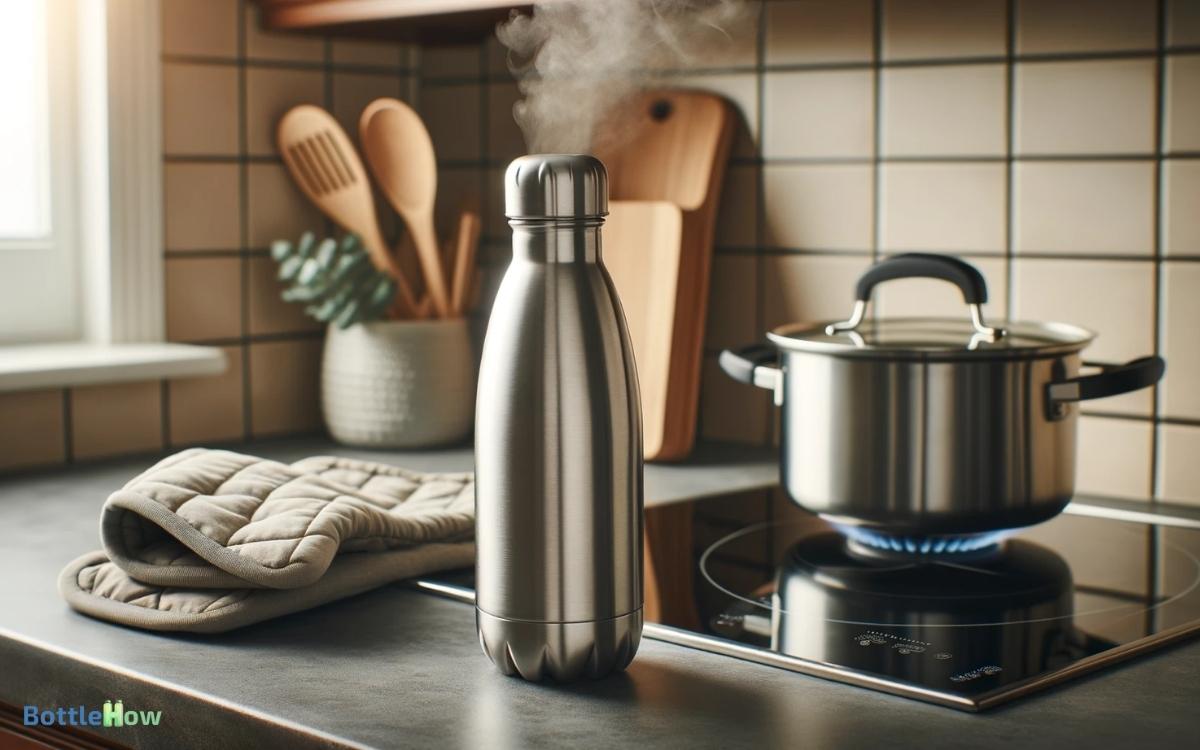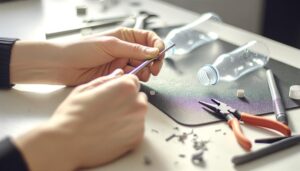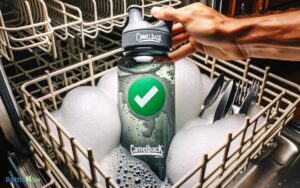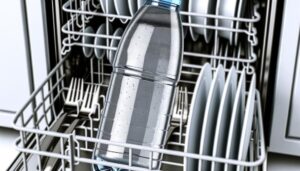Can You Boil Water in a Stainless Steel Water Bottle? Yes!
Yes, you can boil water in a single-walled stainless steel water bottle. Make sure the bottle is high-grade, food-safe stainless steel without any plastic parts.
Never seal the bottle while boiling to prevent pressure build-up. Handle the bottle carefully, using heat-resistant gloves to avoid burns. It’s important to avoid double-walled or vacuum-insulated bottles, as they’re designed to retain temperature, not withstand direct heat.
Proper maintenance and safety precautions are essential for effective boiling and storage. To explore techniques and avoid common mistakes, there’s more valuable information ahead.

Key Takeaways
Understanding Stainless Steel
Stainless steel, an alloy primarily composed of iron, chromium, and nickel, is renowned for its durability and resistance to corrosion. You’ll find it’s an ideal material for products that must withstand harsh conditions.
Chromium, typically making up 10.5% or more of the alloy, forms a thin oxide layer on the surface, preventing rust. Nickel adds further corrosion resistance and enhances formability.
When you choose stainless steel, you’re opting for a material that doesn’t easily degrade, ensuring longevity and reliability. The alloy’s robustness makes it perfect for applications involving water and high moisture levels.
Understanding these properties is vital since they directly affect how well stainless steel performs in various environments, including when you’re considering boiling water in a stainless steel water bottle.
Heat Resistance of Stainless Steel
When you contemplate boiling water in a stainless steel water bottle, it’s important to grasp its high temperature tolerance and thermal conductivity properties.
Stainless steel can withstand significant heat without deforming, making it ideal for high-temperature applications.
Additionally, its excellent thermal conductivity guarantees even heat distribution, preventing hot spots.
High Temperature Tolerance
You might be surprised to learn just how well stainless steel can withstand extremely high temperatures without compromising its structural integrity.
Stainless steel is renowned for its high temperature tolerance, making it an ideal material for applications involving heat. It can endure temperatures up to approximately 1,500 degrees Fahrenheit (816 degrees Celsius) before significant degradation occurs.
This robust heat resistance guarantees that your stainless steel water bottle won’t warp, melt, or release harmful chemicals when exposed to boiling water.
Essentially, the alloy’s durability stems from its specific composition, which includes chromium and nickel.
These elements provide a protective oxide layer, preventing rust and maintaining the bottle’s strength even under intense heat.
Thermal Conductivity Properties
Understanding the thermal conductivity properties of stainless steel is crucial to appreciating its effectiveness in heat resistance.
Stainless steel has a lower thermal conductivity compared to other metals, making it less likely to transfer heat quickly. This characteristic makes it suitable for boiling water safely.
Here’s why:
- Heat Distribution: Stainless steel distributes heat uniformly, preventing hot spots and ensuring even boiling.
- Durability: Its resistance to thermal shock means it won’t crack or deform under high temperatures.
- Safety: Lower thermal conductivity reduces the risk of burns when handling the bottle.
- Efficiency: It retains heat longer, keeping your water hot even after removing it from the heat source.
Knowing these properties helps you understand why stainless steel is excellent for boiling water.
Safety Concerns
Boiling water in a stainless steel water bottle presents specific safety concerns that you must carefully consider.
First, the bottle’s exterior can become extremely hot, posing a risk of burns. Always use a heat-resistant glove or cloth when handling it.
Second, make sure the bottle is designed for high temperatures; some seals or coatings might degrade, leading to potential contamination.
Third, never seal the bottle while boiling water inside. The pressure buildup can cause dangerous explosions.
Lastly, be cautious of steam burns when opening the bottle, as the sudden release of steam can be harmful.
Choosing the Right Bottle
Selecting the ideal stainless steel water bottle for boiling water requires careful consideration of its material quality, design, and safety features.
To guarantee you make the best choice, follow these key guidelines:
- Material Quality: Opt for bottles made from high-grade, food-safe stainless steel (18/8 or 304 grade).
- Insulation: Avoid double-walled or vacuum-insulated bottles, as these are designed to keep temperatures stable and not for direct heating.
- Seamless Construction: Choose bottles with seamless interiors to prevent bacteria buildup and ensure easy cleaning.
- Safety Features: Make sure the bottle has a secure, non-plastic lid that can withstand high temperatures without melting or releasing harmful chemicals.
Boiling Process Overview
To safely boil water in your stainless steel water bottle, follow these precise steps to guarantee efficiency and avoid damage.
First, verify that your bottle is made entirely of stainless steel without any plastic components. These materials can’t withstand high temperatures and may release harmful chemicals.
Next, confirm the bottle’s lid is also stainless steel or remove it entirely during boiling to prevent melting.
Always fill the bottle only halfway to allow space for steam to escape, reducing the risk of pressure buildup.
Step-by-Step Guide
Begin by making sure your stainless steel water bottle is free from any plastic parts or coatings.
Follow these steps to boil water safely and effectively:
- Fill the Bottle: Add water to the bottle, leaving some space at the top to prevent overflow.
- Prepare the Heat Source: Use a campfire, stove, or similar heat source. Confirm it’s stable and capable of supporting the bottle.
- Heat the Bottle: Place the bottle on the heat source, ensuring it remains upright. Monitor the process closely.
- Boil the Water: Wait until the water reaches a rolling boil. This usually takes a few minutes, depending on the heat intensity.
Potential Risks
Boiling water in a stainless steel bottle involves several risks, including potential burns and damage to the bottle itself.
When heating, the metal surface becomes extremely hot, increasing the likelihood of accidental burns upon contact.
Additionally, if the bottle has any plastic components, they could melt or release harmful chemicals.
Over time, repeated boiling may weaken the bottle’s structural integrity, leading to leaks or breakage.
There’s also a possibility of the pressure building up inside the sealed bottle, which can cause dangerous explosions.
Always make sure the bottle is specifically designed to withstand high temperatures and avoid using insulated models, as they aren’t meant for direct heating.
Taking these precautions helps mitigate risks while boiling water.
Benefits of Boiling Water
Despite the potential risks, boiling water in a stainless steel bottle provides numerous benefits. One of the key advantages is ensuring the water is free from harmful microorganisms and pathogens.
By boiling water, you effectively eliminate bacteria, viruses, and parasites that could cause illness. Additionally, you’re also enhancing the taste by removing chlorine and other chemicals.
Here are four key benefits:
- Kills Harmful Microorganisms: Boiling water destroys bacteria and viruses, ensuring it’s safe to drink.
- Improves Taste: By removing chlorine and other impurities, the water tastes better.
- Chemical-Free: Unlike chemical treatments, boiling doesn’t add any unwanted substances to your water.
- Versatile: You can boil water anywhere, making it a reliable method for purifying water outdoors.
Cleaning and Maintenance
To maintain your stainless steel water bottle in top condition, regular cleaning and proper maintenance are crucial.
After boiling water, residues and minerals can accumulate inside the bottle. Use warm, soapy water and a bottle brush to scrub the interior thoroughly.
For stubborn stains or odors, mix a solution of vinegar and baking soda, letting it sit for a few minutes before rinsing.
Avoid using bleach or abrasive cleaners, as these can damage the stainless steel. Dry the bottle completely before storing it to prevent mold and rust.
Inspect the bottle’s seal and replace it if it shows signs of wear. Regular maintenance guarantees your bottle remains hygienic and extends its lifespan, providing you with safe, clean water.
Alternative Methods
You can also utilize solar heating or fire-based methods to boil water in your stainless steel bottle. These methods are especially useful when camping or in emergency situations where electricity is unavailable. However, always ensure your stainless steel bottle is designed to withstand high temperatures to avoid damage or leaks. If you’re considering bringing water bottles into Cedar Point, check the park’s regulations to confirm their policy on outside beverages.
Solar heating involves placing the bottle in direct sunlight with a reflective surface to concentrate the heat.
Fire-based heating requires controlled exposure to an open flame, ensuring the bottle’s safety and water purity.
Solar Heating Techniques
Harnessing solar energy to heat water in a stainless steel bottle can be an efficient and eco-friendly alternative to traditional methods.
You’ll need to follow a few steps to maximize efficiency:
- Select a Solar Reflector: Use a parabolic solar cooker or a reflective surface that concentrates sunlight onto the bottle.
- Position Correctly: Place the bottle at the focal point of the reflector, ensuring maximum sun exposure.
- Monitor Temperature: Use a thermometer to track the water temperature, aiming for at least 70°C (158°F) for effective pasteurization.
- Time Management: Depending on sunlight intensity, it may take 1-2 hours to reach the desired temperature.
Fire-Based Heating Methods
While solar heating offers an eco-friendly method, fire-based heating methods provide a reliable alternative for boiling water in a stainless steel bottle.
You can use a campfire, portable stove, or even a gas burner. First, make sure the bottle is single-walled to avoid pressure buildup. Place the bottle directly in the flames or over the heat source.
Monitor the temperature closely, as stainless steel conducts heat efficiently, reducing boiling time. Always use a heat-resistant glove or cloth to handle the bottle, preventing burns.
Fire-based methods are particularly useful in outdoor settings where other heating options mightn’t be available.
Remember, maintaining safety and proper handling techniques is essential when using fire-based heating methods.
Common Mistakes
One common mistake when boiling water in a stainless steel water bottle is neglecting to remove the cap. This can lead to dangerous pressure buildup and potential injury.
Here are other frequent errors:
- Overfilling the bottle: Leave some space to allow for water expansion when it boils.
- Using a bottle with plastic parts: Plastic can melt or release toxins when exposed to high heat.
- Placing the bottle directly in flames: Direct contact with flames can damage the bottle’s integrity.
- Ignoring signs of wear: Regularly inspect your bottle for dents or damage that could compromise safety.
Expert Tips and Advice
How can you guarantee the safest and most efficient way to boil water in a stainless steel water bottle?
- Start by ensuring your bottle is single-walled; double-walled bottles can explode under high heat.
- Use a clean, high-quality stainless steel bottle to prevent any leaching of materials.
- Avoid overfilling; leave some space to accommodate boiling bubbles.
- Place the bottle directly over a consistent heat source, like a campfire or stove.
- Use a pot holder or tongs to handle the bottle, as it will get extremely hot.
- Finally, let the water cool slightly before opening to avoid steam burns.
Following these steps will help you boil water safely and efficiently in your stainless steel water bottle.
Conclusion
Boiling water in a stainless steel water bottle is like harnessing the power of a trusty steed—reliable and efficient. Make sure your bottle is designed for high heat, and always follow safety guidelines to avoid mishaps.
Clean and maintain it regularly to extend its lifespan. By understanding the process and avoiding common mistakes, you’ll master this technique with ease.
So, equip yourself with the right knowledge and enjoy the benefits of boiling water confidently.





